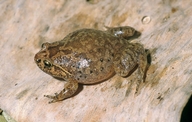|
Plethodontohyla brevipes Boulenger, 1882
| family: Microhylidae subfamily: Cophylinae genus: Plethodontohyla |
 © 2008 Miguel Vences and Frank Glaw (1 of 2) |
|
|
|
Description Similar Species: Most other Plethodontohyla have longer hindlimbs. Rhombophryne testudo has short barbels around the lower lip (Glaw and Vences 1994). Distribution and Habitat Country distribution from AmphibiaWeb's database: Madagascar
Life History, Abundance, Activity, and Special Behaviors Trends and Threats The major threat is habitat loss due to subsistence agriculture, timber extraction, charcoal manufacture, spread of invasive eucalyptus, livestock grazing, and expanding human settlements. The habitat surrounding Parc National de Ranomafana continues to be degraded (Raxworthy and Glaw 2008). Possible reasons for amphibian decline General habitat alteration and loss Comments
References
Glaw, F. and Vences, M. (1994). Amphibians and Reptiles of Madagascar. M. Vences and F. Glaw Verlags GbR., Köln. Glaw, F., and Vences, M. (2007). Field Guide to the Amphibians and Reptiles of Madagascar. Third Edition. Vences and Glaw Verlag, Köln. Raxworthy, C., and Glaw F. (2008). Plethodontohyla brevipes. In: IUCN 2008. 2008 IUCN Red List of Threatened Species. www.iucnredlist.org. Downloaded on 21 April 2009 Originally submitted by: Miguel Vences and Frank Glaw (first posted 2001-10-24) Edited by: Catherine Aguilar (2010-07-19) Species Account Citation: AmphibiaWeb 2010 Plethodontohyla brevipes <https://amphibiaweb.org/species/2348> University of California, Berkeley, CA, USA. Accessed Nov 12, 2024.
Feedback or comments about this page.
Citation: AmphibiaWeb. 2024. <https://amphibiaweb.org> University of California, Berkeley, CA, USA. Accessed 12 Nov 2024. AmphibiaWeb's policy on data use. |



 Map of Life
Map of Life